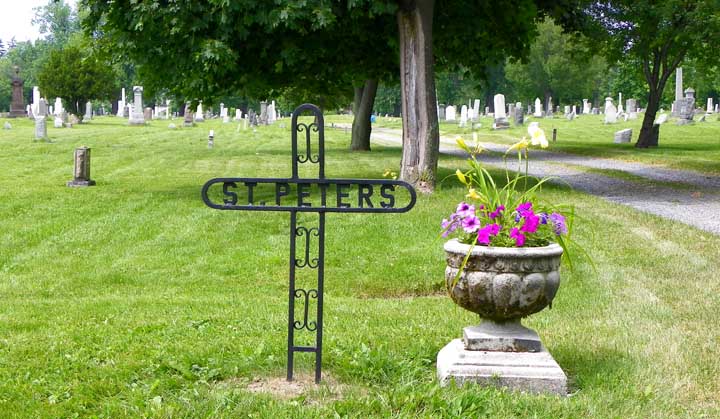|
In operation: |
1859-2010 |
|
Bordering cemetery: |
Beth
Jacob
Cemetery |
|
Style: |
Rural
cemetery |
|
Status: |
Listed
on the National Register of Historic Places - Nomination |
| Reprint: | Bonnie Fleischauer, "Historic Concordia Cemetery: Where Every Stone Tells a Story" |
|
German
Lutheran
Immigrants in Buffalo
Excerpts from the National Register of Historic Places - Nomination for Concordia Cemetery German immigrants settled in Buffalo as early as the 1820s, but large scale immigration began in 1839 as a result of the persecution of Old Lutherans in the German states by Prussian king Frederick William III, a Calvinist. In 1845-1846, famine induced a new wave of German integration, followed by the Revolutions of 1848. Germans who became established in Buffalo arranged for friends and relatives to follow, resulting in migration chains which expanded the immigration population exponentially. The old Fourth Ward in Buffalo's east side became the center of a burgeoning German community numbering almost 7,000 in 1855, approximately 50% of the city's rapidly expanding population. Buffalo's German community remained distinct for several generations and maintained a series of German language institutions in the city including separate schools, clubs, newspapers and a bank. The German and German-American population stood at approximately 40% of the city's population in 1900. Land for the cemetery, a portion of Lot 51 [second map] on the Holland Land Survey, was purchased from John and Magdelene Stellwagen in 1859. The property included a fairly recently-built farmhouse and barn well-suited for use as a cemetery office, caretaker residence and maintenance facility. These buildings remain extant in the cemetery although both have been altered. |
|
Concordia
In
2008
Concordia Cemetery was listed on both the State and National
Registers
of Historic Places. Concordia was cited as a significant
historic
property because of its representation of Buffalo's early German
immigrant
population and its collection of grave monuments of the
period.Formed in 1859, Concordia Cemetery is one of the oldest cemeteries in Western New York. Encompassing 15 acres on Walden Avenue at Sycamore Street, the cemetery is the final resting place for thousands of early residents of Buffalo, including over 500 veterans of which about 150 are Civil War veterans and 1 is a Medal of Honor recipient. There are over 18,000 people of all ethnic backgrounds buried there. See "Historic Concordia Cemetery: Where Every Stone Tells a Story" - Bonnie Fleischauer, 2020 |
|
See
also: Buffalo
and Erie
County’s Wiedrich’s Battery (online September 24,
2022) |
  The cemetery office and maintenance barn and yard are located in the southwest corner of the cemetery: The mid-nineteenth century farmhouse (Gothic Revival style) was integrated into the cemetery in 1859. Like the house, the barn appears to pre-date the cemetery.   19th century wrought-iron fence   2006 replica iron arch. "Concordia"means harmony and refers to the coming-together of the 3 Buffalo church congregations to share this property.      The
cemetery
is divided into three major sections, each corresponding
with
one of the three German Lutheran churches that
established the
cemetery:
First
Trinity Lutheran Church,
St.
Peter's German Evangelical Church, and
(First
Trinity’s
founding pastor was Lebrecht Krause and the church was
located at the corner of William and Milnor Streets.)St. Stephen's Evangelical Church.   Many of the monuments are inscribed in German or in both English and German and feature biblical passages, sentimental phrases and in one case a curse on the deceased's murderer           |